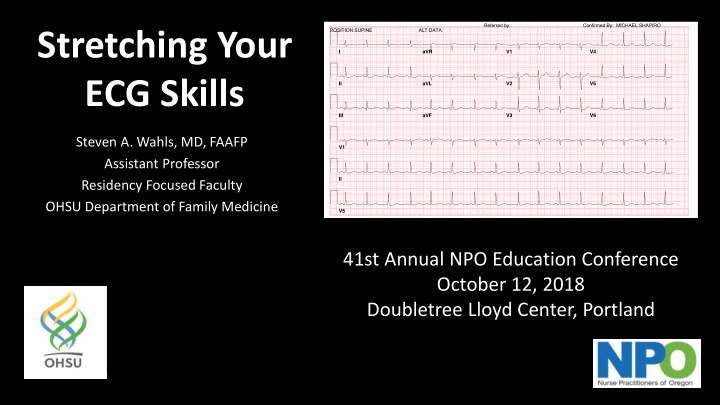



Stretching Your ECG Skills Steven A. Wahls, MD, FAAFP Assistant Professor Residency Focused Faculty OHSU Department of Family Medicine 41st Annual NPO Education Conference October 12, 2018 Doubletree Lloyd Center, Portland
Conflict of Interest: • Nothing to disclose
Goals/ learning points 1.60 second review of what we are looking at… 2.Read ECGs 1.Remember your flow 2.Commit yourself to an interpretation 3.Have fun!
https://commons.wikimedia.org/wiki
From: Katzung B, Trevor, A: Basic & Clinical Pharmacology, 13 th Ed. McGraw-Hill www.accesspharmacy.com
Pinterest: Demystifying the 12 Lead ECG
18-year-old pre-op ECG for knee Wave-Maven surgery. What does this ECG show?
Clues to limb lead reversal Wilson’s central terminus •This directionless “zero lead” lead is calculated as the average input from the three limb leads: WCT = 1/3 (RA + LA + LL). http://www.frca.co.uk Quick guide to spotting LA/RA reversal •Lead I is completely inverted (P wave, QRS complex and T wave). •Lead aVR often becomes positive. •There may be marked right axis deviation. Quick guide to spotting LA/LL reversal •Lead III is completely inverted (P wave, QRS complex and T wave) •The P-wave is unexpectedly larger in lead I than lead II (it is usually the other way around). https://lifeinthefastlane.com
A 65-year-old man complaining of Wave-Maven weakness…
• Mild hyperkalemia K> 5.5 mEq/L • repolarization abnormalities Peaked T waves • Moderate hyperkalemia K> 6.5 mEq/L • progressive paralysis of the atria: P wave widens and flattens, increased PR, loss of P. • Severe hyperkalemia K> 7.0 mE/L • Increased QRS width, sine wave • conduction abnormalities and bradycardia LITFL
Wave-Maven 55-year-old woman: why is she dyspneic? 51
RAE LITFL
LAE LITFL
LITFL Wagner et al. (2007)
weakness. BP 220/80. 75 year old man presented with Dr. Smith’s ECG Blog https://hqmeded-ecg.blogspot.com
ESTES Criteria for LVH Sokolov-Lyon criteria for LVH • Voltage: S wave depth in V1 + tallest R wave height in V5-V6 > 35 mm Non-voltage: • • Increased RW peak time >50ms ("diagnostic" >5 points; "probable" 4 points) V5 or V6 ST depression/ TW inversion • Left side leads
Wave-Maven 32 year-old male runner presenting with shortness of breath and chest discomfort over last hour…
57 year old women complaining of Wave-Maven pounding in her chest…
35 year old Air Transport Pilot for routine screening
ECG Changes seen in Athletes • Sinus bradycardia (≥30 bpm) • Sinus arrhythmia • Ectopic atrial rhythm • Junctional escape rhythm • First-degree AV block (PR interval>200 ms) • Mobitz type I (Wenckebach) second-degree AV block • Incomplete RBBB • Isolated QRS voltage criteria for LVH • Early repolarization (ST elevation, J-point elevation, J waves, or terminal QRS slurring) • Convex ST segment elevation & T wave inversion V1– V4 http://bjsm.bmj.com/content/47/3/125
You are reading ECGs and review this. What Wave-Maven do you see, and what could cause it?
Possible causes for LBBB • Aortic stenosis. Dilated cardiomyopathy. • • Myocardial infarction/ CAD • Primary conduction system disease • Acquired conduction system disease (e.g. Lyme dis) • HTN • AI
Wave-Maven Read this ECG. What is your final impression?
Elderly woman following a fall, with Wave-Maven complaints of fatigue and weakness
ECG missing its clinical data… Ideas?
Wave-Maven 42 year old man with irregular pulse
Wave-Maven 59 year old woman with history of palpitations
• Nathanson L A, McClennen S, Safran C, Goldberger AL. ECG Wave-Maven: Self-Assessment Program for Sources & Students and Clinicians. Re-sources… • Yanowitz, F G. ECG Learning Center. • Life in the Fast Lane • The clinical exercise physiology consortium • ECGPEDIA
Recommend
More recommend